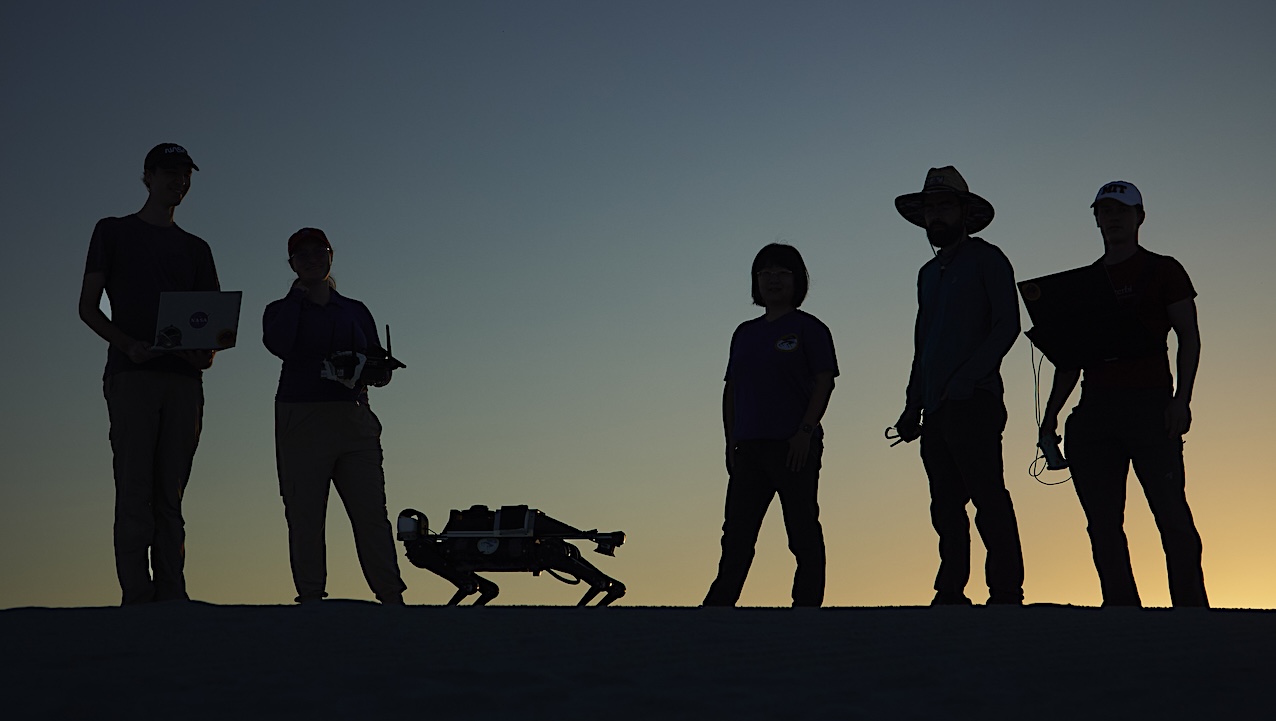Science
Researchers Advance Mars Robot Technology at White Sands

Researchers have made significant strides in preparing a dog-like robot for scientific tasks on Mars, following five days of experiments at White Sands National Park in New Mexico. This testing, part of a broader initiative to explore Mars, involved simulating the planet’s conditions to inform future operations that may include astronauts, quadruped robots, and rovers.
The recent work builds on previous experiments conducted by the team on Mount Hood in Oregon, where they tested similar robotic capabilities to mimic lunar landscapes. “Our group is very committed to putting quadrupeds on the Moon and on Mars,” stated Cristina Wilson, a robotics researcher at Oregon State University. She emphasized that this endeavor represents the next frontier in robotics, leveraging the unique advantages of legged machines.
This initiative is part of NASA’s Moon to Mars program, which aims to develop technology for sustainable lunar exploration and future crewed missions to the red planet. The project, called the LASSIE Project (Legged Autonomous Surface Science in Analog Environments), involves a collaborative effort among experts from multiple institutions, including the University of Southern California, Texas A&M University, Georgia Institute of Technology, University of Pennsylvania, Temple University, and the NASA Johnson Space Center.
Field Tests Push Robotic Boundaries
The recent tests at White Sands mark the second visit by the research team to this national park, with their initial expedition occurring in 2023. They have also conducted previous research at Mount Hood during that same year and into 2024. During these field sessions, scientists collect data on the quadruped robots’ foot interactions with various surfaces, which provides insights analogous to human sensory responses to ground stability.
Wilson explained, “In the same way that the human foot standing on ground can sense the stability of the surface as things shift, legged robots are capable of potentially feeling the exact same thing.” Every step taken by the robot offers valuable data that can enhance its performance in environments like Mars and the Moon.
The challenging conditions at White Sands this month included high temperatures exceeding 100°F, which necessitated early morning testing sessions. Despite these obstacles, the team achieved notable advancements, particularly in refining algorithms that allow the robot to operate autonomously. This independence is crucial; it enables the robot to make its own decisions alongside astronauts, thereby increasing the amount of scientific work possible in extraterrestrial settings.
Looking Ahead: Robotic Exploration on Other Worlds
The team also explored new movement strategies for the robot, tailored to different surface conditions. Such innovations could enhance energy efficiency, an essential factor for missions on distant planets. “There is certainly a lot more research to do, but these are important steps in realizing the goal of sending quadrupeds to the Moon and Mars,” Wilson remarked.
Project leaders include Feifei Qian from the University of Southern California, Ryan Ewing and Kenton Fisher from NASA Johnson Space Center, Marion Nachon from Texas A&M University, Frances Rivera-Hernández from Georgia Tech, Douglas Jerolmack and Daniel Koditschek from the University of Pennsylvania, and Thomas Shipley from Temple University. The research receives funding from NASA’s Planetary Science and Technology through Analog Research (PSTAR) program as well as from the Mars Exploration Program.
As these scientists continue to develop quadruped robots for future missions, their work not only advances robotic technology but also paves the way for increased human understanding of other worlds.
-

 Technology5 months ago
Technology5 months agoDiscover the Top 10 Calorie Counting Apps of 2025
-

 Technology3 weeks ago
Technology3 weeks agoOpenAI to Implement Age Verification for ChatGPT by December 2025
-

 Health3 months ago
Health3 months agoBella Hadid Shares Health Update After Treatment for Lyme Disease
-

 Health3 months ago
Health3 months agoAnalysts Project Stronger Growth for Apple’s iPhone 17 Lineup
-

 Health3 months ago
Health3 months agoErin Bates Shares Recovery Update Following Sepsis Complications
-

 Technology5 months ago
Technology5 months agoDiscover How to Reverse Image Search Using ChatGPT Effortlessly
-

 Technology3 months ago
Technology3 months agoElectric Moto Influencer Surronster Arrested in Tijuana
-

 Technology2 months ago
Technology2 months agoDiscover 2025’s Top GPUs for Exceptional 4K Gaming Performance
-

 Technology5 months ago
Technology5 months agoMeta Initiates $60B AI Data Center Expansion, Starting in Ohio
-

 Technology5 months ago
Technology5 months agoRecovering a Suspended TikTok Account: A Step-by-Step Guide
-

 Health5 months ago
Health5 months agoTested: Rab Firewall Mountain Jacket Survives Harsh Conditions
-

 Lifestyle5 months ago
Lifestyle5 months agoBelton Family Reunites After Daughter Survives Hill Country Floods





















